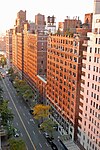JAC Recording, Inc.
JAC Recording, Inc., was a small American recording studio based in New York City at 152 West 58th Street. It was founded in the 1950s by Charles Leighton, a virtuoso classical and jazz harmonica player, who, in the 1950s, took on Jack Arnold as a partner, who also was a pianist. The JAC acronym stood for "Jack and Charlie." The studio was Leighton's personal residence — apartment 8D. Phil Ramone, a prolific recording engineer, entrepreneur, founder, and co-owner of A & R Recording Inc., was first mentored in the art of studio engineering by Leighton at JAC in the late 1950s. Ramone had left JAC in 1958 to start his own recording studio with the help of Jack Arnold, as partner. The "A & R" stood for Arnold and Ramone.
Excerpt from the Wikipedia article JAC Recording, Inc. (License: CC BY-SA 3.0, Authors).JAC Recording, Inc.
West 58th Street, New York Manhattan
Geographical coordinates (GPS) Address External links Nearby Places Show on map
Geographical coordinates (GPS)
| Latitude | Longitude |
|---|---|
| N 40.76566 ° | E -73.97861 ° |
Address
West 58th Street 152
10019 New York, Manhattan
New York, United States
Open on Google Maps









